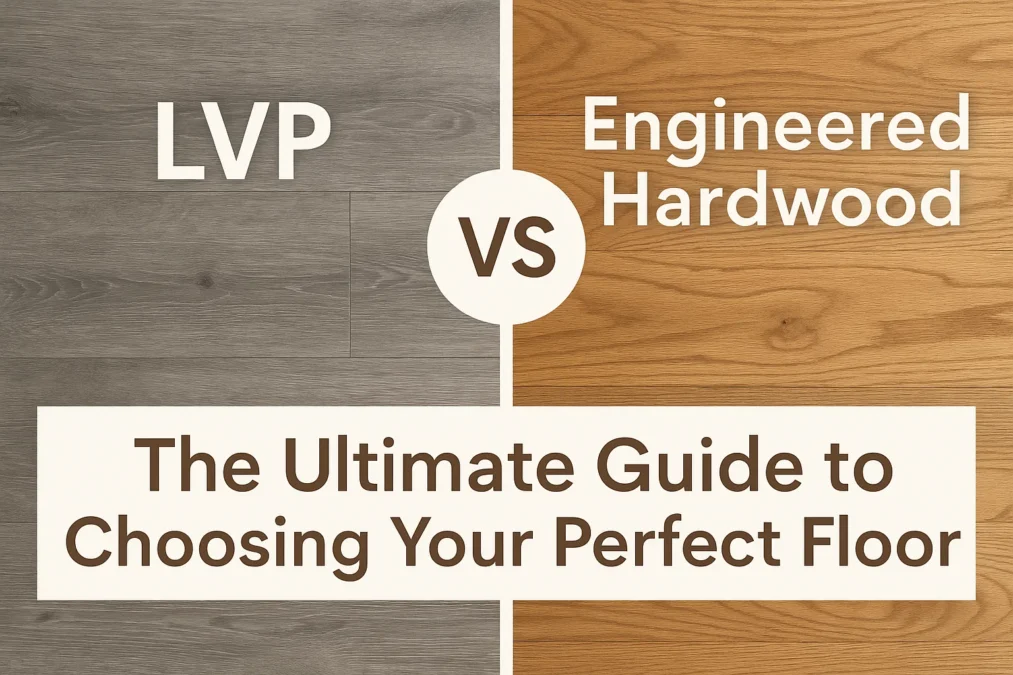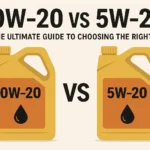You’re staring at the samples scattered across your floor. One is a sleek, modern plank of Luxury Vinyl Plank (LVP), impossibly realistic in its wood-like texture. The other is a sample of engineered hardwood, the real deal with a thin, beautiful slice of authentic oak on top. Both are contenders for your home renovation, and both promise beauty and durability. But which one is truly the right choice for your life, your budget, and your home? The debate between LVP vs engineered hardwood is one of the biggest in modern interior design, pitting a technological marvel against a timeless classic.
This isn’t just a simple question of price or looks. It’s a deep dive into what you value most: the undeniable warmth and authenticity of real wood, or the incredible resilience and practicality of modern vinyl. Your flooring is one of the largest and most impactful design decisions you’ll make. It sets the tone for every room, influences your daily comfort, and represents a significant investment in your property’s value. This comprehensive guide will walk you through every single factor you need to consider. We’ll strip away the marketing jargon and get down to the nitty-gritty details of wear layers, core construction, installation methods, and real-world performance. By the end, you’ll be equipped with all the knowledge you need to confidently choose between LVP and engineered hardwood, ensuring you love your floors for years to come.
Understanding the Contenders: What Exactly Are They?
Before we dive into the head-to-head comparison, it’s crucial to understand what each flooring type is made of. Their core construction is the fundamental reason for their differences in performance, feel, and price.
Luxury Vinyl Plank, or LVP, is a completely synthetic product designed to mimic the look of wood or stone with astonishing accuracy. It’s built in multiple layers. The bottom layer is often a cork or foam backing that provides comfort underfoot and sound absorption. On top of that is a rigid core layer, which is what makes “rigid core LVP” so popular; this core is typically made from stone plastic composite (SPC) or wood plastic composite (WPC), offering incredible dimensional stability and waterproofness. Next is the printed vinyl layer, which is a high-resolution photograph of real wood grain. This layer is what gives LVP its realistic appearance. Finally, everything is sealed under a clear, durable wear layer made of polyurethane. This wear layer is the hero of the story, protecting the floor from scratches, dents, and stains.
Engineered hardwood, on the other hand, is a product that features real, honest-to-goodness wood. Its construction is also layered, but for a different reason. The top layer is a veneer of solid hardwood—like oak, maple, or hickory—sliced from a log. This layer can vary in thickness, which is a critical quality differentiator. Beneath this precious wood veneer are multiple layers (or plies) of cross-directional plywood or high-density fiberboard. This cross-graining technique makes engineered wood far more stable and less susceptible to expansion and contraction due to heat and humidity than traditional solid hardwood. This stability is what allows it to be installed in more areas of the home, including some below-grade basements where solid wood would fail.
The Battle of Aesthetics and Authenticity
When it comes to the pure look and feel of a floor, this is often where the heart argues with the head. There’s an emotional component to flooring that can’t always be quantified by a spec sheet.
Engineered hardwood is real wood. It has the natural grain variations, the subtle color differences, the character marks like knots and mineral streaks that tell the story of the tree it came from. No two planks are exactly alike, creating a floor with depth, character, and organic warmth. The feel underfoot is firm and classic, and it possesses a authenticity that is inherently valuable. It ages and patinas over time, and while it can be scratched, those scratches can often be blended into the character of the wood. For many homeowners, the unique, natural beauty of engineered hardwood is simply unmatchable by any synthetic product. It brings a sense of permanence and quality to a home that is deeply appealing.
LVP has made astronomical leaps in aesthetic quality over the last decade. Gone are the days of repetitive, shiny, and fake-looking vinyl. Modern high-end LVP uses advanced embossing techniques that align textured grooves with the printed wood grain image. This means you not only see the grain, you can feel it under your fingertips and even see realistic wood pores and saw marks. The variety is immense, offering every wood species look, from wide-plank European oak to rustic hickory, and even exotic looks that might be unsustainable or prohibitively expensive in real wood. However, because the image is a photograph, there is a potential for pattern repetition if you purchase a lower-quality product. A keen eye might spot the same “knot” or “grain pattern” repeating throughout a room, which can break the illusion of authenticity.
Durability and Damage Resistance: Which Floor is Tougher?
Durability is a multi-faceted term. It doesn’t just mean “hard.” It means resistance to scratches, dents, moisture, and wear over time. This is where the two products diverge dramatically.
LVP is the undisputed champion of resilience and practicality. Its plastic polymer construction and tough clear wear layer make it incredibly resistant to scratches from pet claws, furniture movement, and high heels. It’s also highly dent-resistant, especially varieties with a stone-based core (SPC). The biggest victory for LVP, however, is its complete waterproofness. A quality LVP floor can withstand spills, leaks, pet accidents, and even wet mopping without warping, staining, or damage. This makes it an ideal choice for kitchens, bathrooms, mudrooms, and basements where moisture is a constant concern. The wear layer is rated with a thickness gauge (e.g., 12 mil, 20 mil, 30 mil) that indicates its expected longevity in residential or commercial settings.
Engineered hardwood is durable in its own right, but it requires a different kind of care. The real wood surface can be scratched and dented, though the hardness of the specific wood species (measured on the Janka scale) plays a big role. For example, a harder species like hickory will resist dents better than a softer species like American walnut. Its primary vulnerability is moisture. While more stable than solid wood, the wood veneer and core are still susceptible to water damage. Prolonged exposure to standing water or significant humidity can cause the planks to cup, warp, and delaminate. However, the key advantage engineered hardwood holds over LVP is its ability to be refinished. Depending on the thickness of the top wear layer, it can be sanded and refinished one, two, or even three times to remove scratches and stains, effectively giving it a new life.
Comfort and Feel Underfoot
The experience of walking on a floor is more than just visual; it’s tactile and auditory. The feel underfoot and the sound a floor makes contribute significantly to the overall comfort of your home.
Engineered hardwood provides a firm, solid, and traditional feel. It’s hard and unyielding, which is a feeling many people associate with quality. However, this can be less comfortable for standing for long periods and can lead to more fatigue. It also tends to be noisier, with footsteps echoing unless a quality underlayment is used. The temperature of wood is also a factor; it feels cool to the touch but doesn’t tend to hold coldness like tile. From an acoustic perspective, without a good pad, engineered wood can create hollow sounds and amplify noise in a room.
LVP offers a different comfort profile. Most LVP products come with an attached underlayment or pad. This layer provides a slight cushioning effect that makes standing and walking more comfortable, reducing leg and back fatigue. This gives it a softer, more forgiving feel underfoot. The attached underlayment also acts as a sound dampener, reducing the noise of footsteps and the hollow sound that can occur with floating floors. Furthermore, because it’s not as dense as wood, LVP tends to feel warmer underfoot, which can be a pleasant benefit in colder climates. For families with young children who play on the floor, this slight give and warmth can be a major advantage.
Installation Methods and Considerations
The installation process can greatly influence your project’s timeline, cost, and even which rooms are suitable for your new floor. Both LVP and engineered hardwood offer flexible installation options, but they differ in execution.
LVP is overwhelmingly installed as a floating floor. This means the planks are not glued or nailed to the subfloor but are instead locked together tightly along their edges using a click-lock system. This creates a single, unified “mat” of flooring that rests on top of the subfloor. This is a massive advantage for DIY enthusiasts, as it requires fewer specialized tools and skills. It can be installed quickly over most existing subfloors, including concrete, plywood, and even existing vinyl or tile (within reason). The floating nature also allows for expansion and contraction. Some LVP can also be glued down, which is more common in commercial applications.
Engineered hardwood is much more versatile in its installation methods. It can be stapled or nailed down to a wood subfloor, which is a traditional and very secure method. It can also be glued down directly to a concrete subfloor or to a wood subfloor, which helps to reduce noise and creates a very solid feel. Finally, many engineered wood products now also feature a click-lock system, allowing them to be installed as a floating floor. The chosen method often depends on the thickness of the product, the subfloor type, and the manufacturer’s specifications. While a skilled DIYer might attempt a click-lock engineered wood installation, the glued-down or nailed-down methods are best left to professional installers to ensure a flawless and long-lasting result.
Sheetrock vs Drywall: Understanding the Differences, Uses, and Costs
Cost Analysis: Upfront Investment and Long-Term Value
The financial aspect of this decision is more complex than just the price per square foot of the material. You must consider the total cost of the project, including installation, underlayment, and long-term maintenance.
On a pure material cost basis, LVP almost always wins as the more affordable option upfront. You can find decent quality LVP starting in the $2.50 to $5 per square foot range. Mid-range products with better wear layers and realistic embossing typically fall between $3.50 and $7 per square foot. The true high-end, thick, wide-plank LVP can reach up to $10+ per square foot. Because it’s so DIY-friendly, you can save thousands on installation costs if you’re handy. Even if you hire a pro, installation is generally quicker and less labor-intensive than for many engineered wood installations.
Engineered hardwood is a premium product with a higher price tag. Material costs can start around $3 to $5 per square foot for a basic product with a thin wear layer, but a good quality product you’d want in your home typically ranges from $6 to $12+ per square foot. Exotic species or very thick wear layers can push that price even higher. Installation costs are also higher, especially for glue-down or nail-down methods, which require more skill and time. However, it’s crucial to consider the long-term value. Engineered hardwood is still real wood, and it is generally perceived to add more resale value to your home than LVP. Furthermore, its ability to be refinished extends its lifespan dramatically, potentially making it a more valuable investment over 20 or 30 years.
Environmental and Health Impact
In today’s world, the sustainability of materials and their impact on indoor air quality are important considerations for many homeowners.
The environmental story of engineered hardwood is relatively straightforward. It uses a fraction of the precious hardwood that a solid wood floor does, making it a more sustainable choice by utilizing the tree more efficiently. Look for products certified by the Forest Stewardship Council (FSC), which ensures the wood is sourced from responsibly managed forests. From an indoor air quality perspective, engineered wood finished on-site with oil or water-based polyurethane can off-gas VOCs (Volatile Organic Compounds) during and after installation. However, many pre-finished options now use factory-applied finishes that are low-VOC or VOC-free, and these fumes have largely dissipated by the time the product is in your home.
LVP is a PVC-based product, and its environmental impact is a common concern. The production of PVC involves chlorine and creates chemical byproducts. Furthermore, LVP is not biodegradable. On the positive side, its incredible durability means it doesn’t need to be replaced as often, which is a form of sustainability. The biggest health concern historically with vinyl flooring was off-gassing of phthalates (used to make PVC flexible) and VOCs. The industry has largely responded to these concerns. Most major brands now produce phthalate-free LVP and use low-VOC formulas. It is absolutely critical to check for certifications like FloorScore or GREENGUARD Gold, which verify that the product meets strict standards for low chemical emissions, ensuring it is safe for your indoor air quality.
Ideal Applications: Where Each Floor Shines
Based on their properties, each flooring type has a natural home where its strengths are maximized and its weaknesses are minimized.
LVP is the ultimate utility player. Its waterproof nature makes it the undisputed king for moisture-prone areas. It is the perfect choice for:
- Kitchens: Spills and leaks are no cause for panic.
- Bathrooms: It can handle the humidity from showers and baths.
- Basements: It’s immune to the moisture that can seep through concrete.
- Mudrooms: It laughs in the face of wet boots and muddy paws.
- High-Traffic Areas: Hallways, playrooms, and entryways benefit from its scratch resistance.
- Rental Properties: Its durability and easy maintenance are ideal for tenants.
Engineered hardwood brings warmth and value to the traditional living spaces of a home. It excels in:
- Living Rooms: It creates a warm, inviting, and formal atmosphere.
- Dining Rooms: It elevates the aesthetic for entertaining.
- Bedrooms: The authentic feel and warmth are perfect for cozy spaces.
- Home Offices: It adds a sense of prestige and value.
- Anywhere You Want Authenticity: If the feel and value of real wood are non-negotiable, this is your choice.
Maintenance and Cleaning Routines
Keeping your floors looking pristine requires different approaches for these two materials. Thankfully, both are relatively low-maintenance compared to other flooring types.
Maintaining LVP is famously easy. Its plastic wear layer is resistant to stains and doesn’t require waxing or sealing. Daily dry dust mopping or vacuuming (without a beater bar) is sufficient to remove grit and dirt. For a deeper clean, damp mopping with a manufacturer-approved vinyl floor cleaner is all that’s needed. It’s crucial to avoid abrasive cleaners, steel wool, or steam mops, as the high heat from a steam mop can damage the wear layer and potentially break down the adhesives holding the planks together over time. Wiping up spills promptly is still recommended to prevent slips, but not to prevent floor damage.
Caring for engineered hardwood is similar to caring for solid wood. You’ll want to sweep or vacuum regularly to prevent abrasive grit from scratching the surface. You should use a dedicated hardwood floor cleaner for damp mopping; never use excessive water, as it can seep into the seams and damage the wood. Felt pads should be placed under furniture legs to prevent scratching, and area rugs should be used in high-traffic zones. The biggest advantage is that if the finish becomes worn or scratched over many years, the option to recoat or refinish it can make it look brand new again, a feature LVP does not have.
Resale Value and Perceptions of Home Buyers
Your flooring choice is an investment, and it’s wise to consider how it might be perceived by a future home buyer.
Engineered hardwood is consistently viewed as a premium upgrade by real estate agents and home buyers. It falls under the category of “hardwood floors,” which is a major buzzword and a sought-after feature in the housing market. It signals quality, permanence, and care. While buyers may not know the difference between solid and engineered wood at a glance, they recognize and value real wood. This perception can directly translate into a higher appraised value and a faster sale for your home. It’s a classic feature that never goes out of style.
LVP’s impact on resale value is more nuanced. It is no longer seen as a “cheap” vinyl like the sheet goods of the past. Informed buyers recognize its durability and waterproof benefits, especially in areas like kitchens and basements. However, it is still not generally valued as highly as real wood. A buyer might see LVP and think “nice, new flooring,” whereas they see real wood and think “premium upgrade.” The key is to be transparent. Marketing your home as having ” waterproof luxury vinyl plank flooring in the kitchen and bathrooms” can be a smart selling point, highlighting its practical advantages without pretending it’s something it’s not.
Making Your Final Decision: A Guide to Personal Choice
There is no universal winner in the LVP vs engineered hardwood debate. The best choice is a deeply personal one that depends on your specific circumstances, priorities, and lifestyle. To help you decide, ask yourself these questions:
What is my absolute top priority? Is it durability against pets and kids (leaning LVP), or is it authentic beauty and resale value (leaning Engineered Hardwood)? Where in my house is this floor going? A wet basement demands LVP, while a formal living room is a classic spot for engineered wood. What is my budget, both for initial installation and for long-term upkeep? LVP wins on upfront cost, while engineered wood can be a longer-term investment. How important is DIY installation to me? If you want to save money and install it yourself, LVP is the far more accessible option. What is my tolerance for maintenance? If you want to simply damp mop and not worry, LVP is easier. If you don’t mind a bit more careful upkeep for a real wood look, engineered is fine.
Comparison Table: LVP vs Engineered Hardwood at a Glance
| Feature | Luxury Vinyl Plank (LVP) | Engineered Hardwood |
|---|---|---|
| Composition | Synthetic layers (PVC, wear layer, printed design, core) | Top layer of real hardwood with a plywood core |
| Water Resistance | 100% Waterproof – ideal for wet areas | Water-Resistant to spills, but vulnerable to standing water |
| Durability | Highly scratch, dent, and stain-resistant | Susceptible to scratches and dents; can be refinished |
| Aesthetics | Highly realistic wood/stone looks; potential for pattern repeat | 100% authentic, natural wood look with unique grain variations |
| Feel Underfoot | Softer, warmer, slightly cushioned with underlayment | Firm, solid, hard, and traditional |
| Installation | Primarily floating (DIY-friendly); some glue-down | Glue-down, nail-down, or floating (often requires pro) |
| Cost (Installed) | $3.50 – $10+ per sq. ft. | $6 – $15+ per sq. ft. |
| Lifespan | 10-25 years | 20-100+ years (depending on wear layer and refinishing) |
| Resale Value | Good, seen as a quality upgrade but not equal to wood | Excellent, adds significant value as “hardwood floors” |
| Best For | Kitchens, bathrooms, basements, mudrooms, high-traffic areas | Living rooms, bedrooms, dining rooms, home offices |
Quotes from Industry Experts
“We’re seeing a massive shift where LVP is no longer just a budget alternative. It’s a deliberate, design-led choice for active families who need performance without sacrificing style. However, for the timeless feel and value, real wood still connects with buyers on an emotional level.” – Sarah Richardson, Certified Flooring Inspector & Realtor
“The number one question I get is ‘Can I put this in my kitchen?’ For LVP, the answer is an easy yes. For engineered wood, it’s a ‘yes, but…’ You must be diligent about wiping up spills immediately and maintaining a stable humidity level to prevent issues.” – Mark Watson, 25-year Flooring Installation Professional
Conclusion
The journey through the world of LVP vs engineered hardwood reveals two exceptional flooring options, each a champion in its own right. LVP stands as the titan of practicality, offering unparalleled waterproof durability, comfort, and ease of installation at a friendly price point. It is the modern solution for busy, messy, real-life living. Engineered hardwood remains the king of authenticity, offering the undeniable beauty, solid feel, and long-term value of real wood that connects us to nature and tradition.
Your perfect choice is the one that aligns with your reality. Choose LVP if your life involves pets, kids, spills, and you need a worry-free floor that can handle everything in moisture-prone areas. Choose engineered hardwood if you crave the authentic character of wood, are prepared for a slightly higher maintenance routine, and want to invest in the classic aesthetic and resale value of your home. There is no wrong answer, only the right answer for you. By weighing the factors of aesthetics, durability, cost, and lifestyle outlined in this guide, you can move forward with confidence, knowing your new floor will be a source of joy for years to come.
Frequently Asked Questions (FAQ)
What is the biggest disadvantage of engineered hardwood?
The biggest disadvantage of engineered hardwood is its vulnerability to moisture. Unlike LVP, it is not waterproof. Prolonged exposure to water or significant humidity fluctuations can cause the planks to swell, warp, cup, or delaminate. This makes it a riskier choice for bathrooms, laundry rooms, or basements that may be prone to dampness or flooding.
Can you tell the difference between LVP and real hardwood?
In high-quality LVP, it can be very difficult to tell the difference from a distance. However, upon closer inspection, most people can. The feel is different—LVP is softer and warmer, while hardwood is harder and firmer. The sound when walking is also a tell; hardwood has a more solid “thump,” while LVP can have a slightly hollow sound. Visually, while LVP is incredibly realistic, a trained eye might detect pattern repetition in lower-quality options.
Does LVP decrease home value?
LVP does not typically decrease home value; in fact, it increases it compared to having worn-out or outdated flooring. However, it generally does not increase value to the same extent as real engineered hardwood. Buyers perceive real wood as a premium upgrade. The key is to market LVP honestly, highlighting its durability and waterproof benefits, which are attractive to many modern buyers.
How long does LVP flooring last?
The lifespan of LVP flooring depends heavily on the quality of its wear layer. A good quality LVP with a thick wear layer (20 mil or more) in a residential setting can last between 15 to 25 years. Lower-quality products may show wear sooner. While incredibly durable, it cannot be refinished like wood; once the wear layer is compromised, the floor must be replaced.
Which is better for a kitchen with kids: LVP or engineered hardwood?
For a kitchen with kids, LVP is almost universally the better choice. Its 100% waterproof nature means spilled juice, milk, or water is no cause for alarm. You can simply wipe it up without fear of damaging the floor. Its superior scratch resistance also handles dropped toys, chairs being scooted, and general high-traffic chaos far better than the real wood surface of engineered hardwood.



